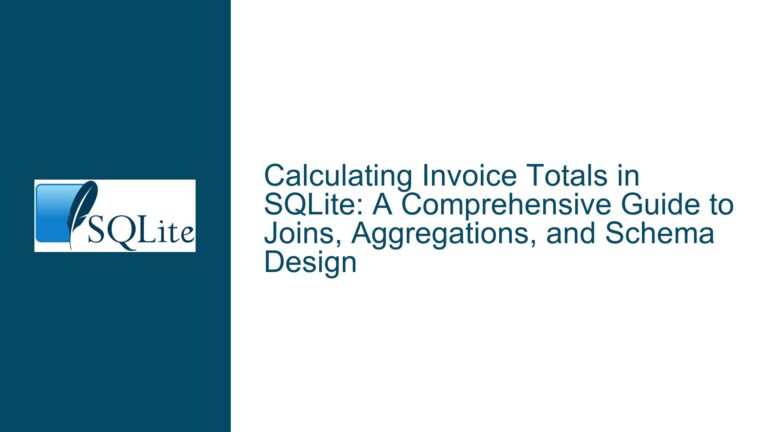Custom Collation in SQLite: Calculated Fields and Performance Considerations
Custom Collation in Table Definition vs. Query Syntax
When working with SQLite, one of the more nuanced decisions you may face is whether to apply custom collation as part of the table definition or within the query syntax. This decision can have significant implications for both the performance and maintainability of your database operations.
Custom collation functions, such as the one created using sqlite3_create_collation, allow you to define how strings are compared and sorted. In the example provided, the custom collation function my_collation is designed to handle natural number sorting, ensuring that strings containing digits are sorted in a human-readable order (e.g., "ab3x" before "ab100"). Additionally, the function handles case sensitivity for Unicode characters, which can be particularly useful in internationalized applications.
The primary advantage of applying custom collation as part of the table definition is that it ensures consistency across all queries that interact with the column. Once a collation is defined at the column level, any query that sorts or compares that column will automatically use the specified collation. This can simplify query writing and reduce the risk of errors, as developers do not need to remember to apply the collation in every query.
However, there are also disadvantages to this approach. Defining collation at the table level can lead to performance overhead, especially if the collation function is computationally expensive. Every comparison operation on the column will invoke the custom collation function, which can slow down queries, particularly those involving large datasets or complex sorting operations. Additionally, if the collation function is updated or changed, all queries that rely on the column will be affected, potentially requiring extensive testing and validation.
On the other hand, applying custom collation within the query syntax offers greater flexibility. You can choose to apply the collation only when it is needed, which can help optimize performance. For example, in the provided query, the custom collation is applied only to the sortname field, which is a calculated field derived from name1 and name2. This allows you to use the default collation for other operations, reducing the overall computational load.
However, this approach also has its drawbacks. Applying collation within the query syntax can make queries more complex and harder to maintain. Developers must remember to include the collation in every relevant query, which can lead to inconsistencies if the collation is accidentally omitted. Additionally, if the collation function is used frequently across multiple queries, the repeated invocation of the function can still lead to performance issues.
In summary, the choice between defining custom collation at the table level or within the query syntax depends on the specific requirements of your application. If consistency and simplicity are paramount, defining collation at the table level may be the better option. However, if performance and flexibility are more important, applying collation within the query syntax may be preferable.
Natural Number Sorting and Unicode Case Sensitivity in Collation Functions
The custom collation function my_collation in the provided example serves two primary purposes: natural number sorting and Unicode case sensitivity. Understanding how these features work and their implications is crucial for optimizing your database operations.
Natural number sorting is a technique that ensures strings containing digits are sorted in a human-readable order. For example, "ab3x" should come before "ab100", even though a standard lexicographical sort would place "ab100" first due to the comparison of the first character (‘1’ vs. ‘3’). This is particularly useful in applications where users expect to see sorted lists that match their intuitive understanding of numerical order.
To achieve natural number sorting, the collation function must parse the strings and compare the numerical portions accordingly. This can be computationally expensive, especially for long strings or large datasets. The function must identify sequences of digits, convert them to numerical values, and then perform the comparison. This additional processing can slow down sorting operations, particularly if the collation function is applied to a large number of rows.
Unicode case sensitivity is another important feature of the collation function. In many applications, it is necessary to perform case-insensitive comparisons, especially when dealing with user input or internationalized text. However, standard case-insensitive collation in SQLite may not handle all Unicode characters correctly. A custom collation function can ensure that case sensitivity is handled appropriately for all characters, including those outside the ASCII range.
However, implementing Unicode case sensitivity in a collation function can also introduce performance overhead. The function must handle a wide range of characters and their case mappings, which can be more complex than simple ASCII case conversion. Additionally, if the collation function is used frequently, the cumulative performance impact can be significant.
In the provided example, the collation function is used to sort a calculated field sortname, which is derived from name1 and name2. The calculation involves stripping articles like "the", "a", and "an" from the beginning of name1 to create a more sortable version of the name. This approach can improve the accuracy of sorting, but it also adds an additional layer of complexity to the query.
One potential optimization is to store a precomputed sortable version of the name in the database. For example, you could add a column sortname to myTable and populate it with the derived value. This would allow you to apply the custom collation directly to the sortname column, reducing the need for on-the-fly calculations in your queries. However, this approach requires additional storage and maintenance, as the sortname column must be updated whenever name1 or name2 changes.
Another consideration is the use of the ICU extension for SQLite, which provides robust support for Unicode collation and case sensitivity. The ICU extension can handle many of the complexities of Unicode text, including case mapping and locale-specific sorting rules. However, it may not support natural number sorting out of the box, so you may still need to implement a custom collation function for that specific requirement.
In conclusion, natural number sorting and Unicode case sensitivity are powerful features that can enhance the usability of your database, but they come with performance trade-offs. Careful consideration of these trade-offs is necessary to ensure that your database operations remain efficient and scalable.
Implementing PRAGMA journal_mode and Database Backup Strategies
When working with custom collation functions and calculated fields in SQLite, it is important to consider the broader context of database performance and reliability. One key aspect of this is the use of PRAGMA journal_mode to control how SQLite handles transactions and recovery. Additionally, implementing robust database backup strategies can help protect your data and ensure continuity in the event of a failure.
The PRAGMA journal_mode setting determines how SQLite manages the write-ahead log (WAL) or rollback journal, which are used to ensure atomicity and durability of transactions. The default journal mode is DELETE, which creates a rollback journal file that is deleted after each transaction. However, other modes, such as WAL, TRUNCATE, and PERSIST, offer different trade-offs in terms of performance and reliability.
The WAL mode, in particular, can provide significant performance benefits for databases with high write concurrency. In WAL mode, writes are appended to a separate WAL file, rather than overwriting the main database file. This allows multiple readers to access the database simultaneously without blocking, and it can reduce the overhead of frequent write operations. However, WAL mode also requires careful management of the WAL file, as it can grow large over time if not properly checkpointed.
For databases that use custom collation functions and calculated fields, the choice of journal mode can have a direct impact on performance. Custom collation functions, especially those that perform complex string manipulations, can increase the computational load of write operations. Using WAL mode can help mitigate this by reducing contention between readers and writers, allowing the database to handle more concurrent operations without degradation in performance.
However, it is important to note that WAL mode may not be suitable for all use cases. For example, if your database is frequently accessed by applications that do not support WAL mode, or if you are working in an environment with limited storage, you may need to use a different journal mode. In such cases, TRUNCATE or PERSIST modes may offer a better balance between performance and resource usage.
In addition to choosing the appropriate journal mode, implementing a robust database backup strategy is essential for protecting your data. SQLite provides several mechanisms for backing up databases, including the .backup command, the sqlite3_backup API, and third-party tools. Each of these methods has its own advantages and disadvantages, and the choice of backup strategy will depend on your specific requirements.
The .backup command is a simple and effective way to create a backup of an SQLite database. It works by copying the entire database file to a backup location, ensuring that the backup is consistent and up-to-date. However, this method can be slow for large databases, and it may not be suitable for real-time backup scenarios.
The sqlite3_backup API provides more flexibility and control over the backup process. It allows you to create incremental backups, which can be faster and more efficient than full backups. Additionally, the sqlite3_backup API can be used to create backups while the database is in use, making it suitable for applications that require continuous availability.
Third-party tools, such as rsync or rclone, can also be used to back up SQLite databases. These tools offer advanced features, such as compression, encryption, and cloud storage integration, which can enhance the security and reliability of your backups. However, they may require additional configuration and maintenance, and they may not be as tightly integrated with SQLite as the built-in backup mechanisms.
In conclusion, implementing PRAGMA journal_mode and a robust database backup strategy are essential for maintaining the performance and reliability of your SQLite database. By carefully considering the trade-offs of different journal modes and backup methods, you can ensure that your database remains efficient, scalable, and resilient in the face of potential failures.






